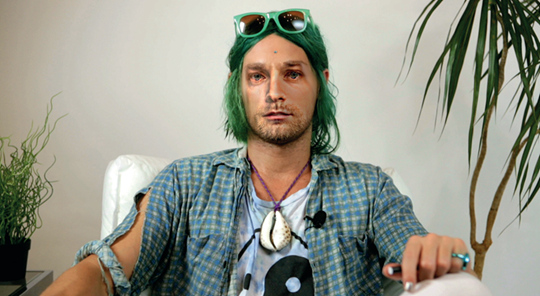LIQUIDITY
| July 13, 2015 | Post In 2015年6月号

Courtesy the artist and 47 Canal, New York
In a recent Guardian article about the fundamental chemical weirdness of water, science correspondent Alok Jha writes, “Water is not only attracted to itself but will stick to almost anything else it comes across.” He could just as well be speaking about the recent liquid tendencies of the art world and online culture. From the much-maligned micro-genre of seapunk to the prevalence of energy drinks in post-internet sculpture, there is a certain moistness to this cultural moment.
The blogging platform Tumblr plays an important part in this water table of critical fluids, collecting condensation and recirculating it to the communities of net art and indie music, which then allow for runoff into the mainstream. The dolphin GIFs, aqua sparkles, and new-rave mermaids of seapunk quickly washed up onto the stages of pop stars like Rihanna and Azealia Banks, and the shelves of Urban Outfitters and Hot Topic. In a more conceptual vein, liquidity in general and energy drink sym¬bolism in particular has been popping up in the works of young artists online and off for several years, and could be considered a stylistic tic of the post-internet movement. Mutated Monster Energy logos, social commentary smoothies, Excalibur-esque sword sculptures fashioned from Axe body spray can be found across the web and the white cube, highlighting an engagement with liquid and, particularly, the ominous dimensions of liquid energy in the work of artists and collectives like Timur Si-Qin, Kari Altmann, Josh Kline, The Jogging, K-Hole, and DIS Magazine, to name a few. In the typical ouroboros of art and commerce, some brands now embrace the art ambiguously critiquing them—see Ryder Ripps’s Hyper Current Living (2013) and Alone To-gether (2015), two projects commissioned by Red Bull Studios New York.

Courtesy Night Gallery and the artist
The question remains: what prompted the flood, and is the tide turning back? If aesthetics reflects anxieties as much as desires (and the complex interplay between the two), this neo-liquidity can be linked to the fraught fluids of seawater (rising ocean levels due to global climate change) and petroleum (diminishing fossil fuel reserves). On a metaphoric level, it can be related to the global economic crisis and concerns about liquid assets and the flows of offshore capital, as well as transparency and the slippery nature of private online data in a post-Snowden world. But none of these readings seem to completely account for the deeply, unaccountably grotesque affect of, say, a coffee machine filled with blue Windex (or Gatorade?) perched in a quasi-pastoral scene of moss and rocks. This piece seems to recognize liquid’s complex objecthood through its ties to recent trends in contemporary philosophy like object-oriented ontology, dark vitalism, and, particularly, the recent texts Slime Dynamics by Ben Woodard and Cyclonopedia by Reza Negarestani.
In the posthuman turn, as we grapple with rising sea levels, mass extinction, and energy crises along with the rise of automation and artificial intelligence, liquids and slimes become symbols for humanity itself. That sloshing sound is the echo of messy, wet f lesh encountering the cold, dry machine.

